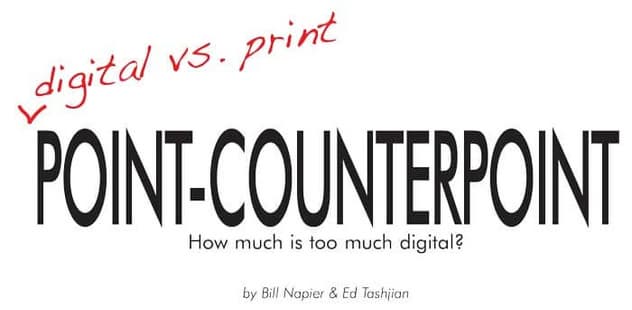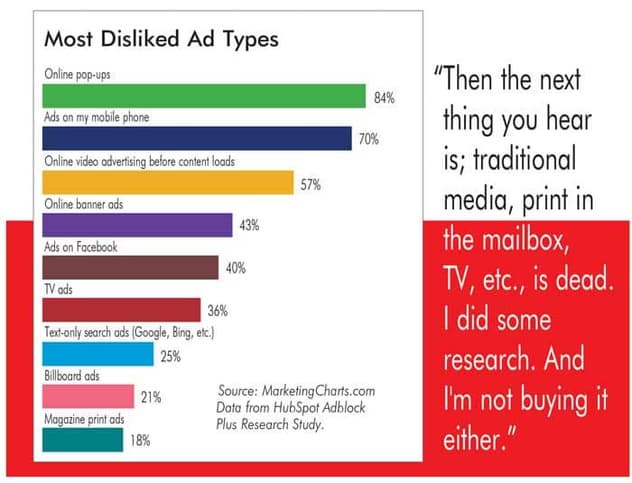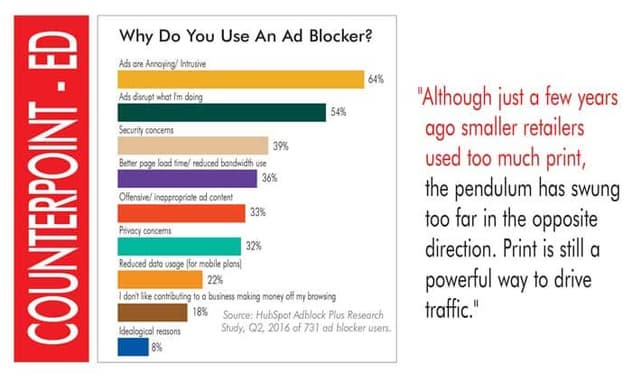
Bill thinks there is too much hype about digital-only retail marketing. Ed takes a more nuanced view.
Editor’s Note: Here's more from Furniture World's point/counterpoint duo, Bill Napier and Ed Tashjian. This is their third installment, having previously debated celebrity licensing and the millennial myth.
Point: Bill Napier
Are you buying into all the hype about only using digital marketing to promote your retail store? I'm not. I'll write and you decide.
All I ever hear about is Snapchat this, Facebook that, Instagram wherever, WhatsApp, Twitter me twit! You have to market here, there and everywhere on these digital platforms. Those of you who reach out in a small or big way using these platforms know what I mean.
Let me be upfront. I'm not saying all digital inbound marketing is bad, I'm just saying if that's all you're spending your money on, you're missing more than 30 to 70 percent of your market!
The other thing you hear is that traditional media, such as newspapers, mail in the mailbox, TV, etc., is dead. Well, I did some research. My conclusion is that I'm not buying this assertion either. Here's why:
First off, who are you marketing to on all these digital platforms? Generation Z, Millennials, Baby Boomers.
Second, with so many of these platforms, who has time to keep up with them all? I sure don't think it's people who work for a living, unless they're scamming their employers.

Have you ever heard of AdBlocker+? Yep, they block Ads. How about Ghostery? Ghostery detects and blocks tracking technologies to speed up page-loads, eliminate clutter, and protect your data. These platforms are very popular, and there's a good chance your ads aren't even seen!
AdBlocker is HUGE. I use it plus Ghostery, and it looks like a ton of those people you are targeting do too! The majority of ad blockers target banner ads and pop-up ads, and many block native and search ads as well. Some completely remove all advertising from a page while others focus on ads that compromise privacy by blocking tracking codes. Are you starting to catch my drift here?
I’m frustrated because I hear people who really know nothing about consumer marketing, tell retailers how they should spend their money. They have NO CLUE because they didn't do their due diligence. This causes many small and medium retailers to enter a fad zone of app plethora, blindly wasting their precious time and marketing funds.
OK, I'll get some blow-back here because someone will chime in and say that Facebook works for them. I bet it can, for a while, but let me tell you how I and 40 percent of other Facebook users (see the chart below) deal with retailers that clutter their news feeds. We hide them. It’s bye-bye and they are gone forever!
So, before you waste your money on the next FAD, consider some of these tried and true marketing mediums that still work.
Direct Mail - This is the stuff delivered to your mailbox such as inserts and post cards. Direct mail has a household response rate of 3.7%. Compare that to these smaller number engagements for digital:
- .2% mobile,
- .1% email,
- .1% social media,
- .02% Internet display
Notice that there's a DOT before the percentage number, not looking so hot, is it? And, direct mail looks even better when you consider that women, who have huge purchasing power, love to receive print in the mail. Studies show that mail is picked up by the same person 91% of the time and 81% of these people are women. Women make more than 80% of all purchasing decisions, and more than 85% of all household purchases.

Here are some other useful facts:
- 92% of shoppers say they prefer direct mail/ads in the mailbox for making purchasing decisions. 70% are curious to find out what’s in their mailbox.
- 77% of people sort through their physical mail as soon as they get it (Epsilon)
- 74% always or sometimes notice advertising in direct mail.
- 42 percent of recipients read or scan mail pieces.
- 51% prefer companies to use a combination of mail and email when communicating with them.
- 23% bought or ordered something as a result of receiving direct mail in the last 12 months.
- Median household ROI for direct mail/newspaper in the mailbox is 18-20%.
And, if you're still hooked on reaching Millennials after reading Ed Tashjian’s and my Point/Counterpoint article in the March/April 2017 issue of Furniture World (www.furninfo.com/Authors/Bill_Napier/42), they like it too! Thirty-six percent of people under 30 look forward to checking the mail each day.
Even the Wall Street Journal has piped in on this topic, writing that, “the good news is that newspaper inserts drove more retail shoppers than digital ads, and are without a doubt the most powerful drive-to-retail media available to marketers."
Summary
Print is not dead. If you are not using it as part of your marketing integration to attract, educate and engage your audience, your business will probably become pedestrian, if it hasn't already!
Print is still one of the main influencers when it comes to consumer purchase decisions.
The thing with digital ads is they are fleeting. They’re there one second and gone the next. But newspapers have real lasting power and tend to stick around in consumers’ homes longer than most other media. This means people spend more time interacting with inserts, browsing deals and offers.
Other recent research by Research and Analysis of Media (RAM), an international media research company, confirms the crucial role newspaper inserts play in consumer marketing. Data shows that nearly nine in 10 media consumers use newspaper inserts.
In case you are wondering at this point, I don't sell print, direct mail, or traditional media of any kind. So, why am I writing this?
I just get really irritated when so called marketers, tell people how to market their stores’ STUFF without having a clue about how furniture shoppers engage.
There are too many small and medium sized retailers struggling, but all the Big Retailers still use print in their mix. Although just a few years ago smaller retailers used too much print, the pendulum has swung too far in the opposite direction. It is still a powerful way to drive traffic.
Counterpoint Ed Tashjian
Once again Bill makes some excellent points, but little in life or marketing is “all or nothing.” Read any marketing director job description and they demand experience and competence in Display, Re-targeting, SEO/SEM, Content, Email, Affiliates, Social, Mobile. If you are a marketing executive, you are doing yourself a disservice (and making yourself unemployable) if you do not explore these as well as the traditional media.
Much has changed in terms of tools and tactics over my marketing career. What has not changed is the strategic goal of marketing: Profitably growing revenue by delivering value from your customer’s perspective, and equally important, capturing some of that value for your company. The profit part means spending less money to acquire customers then you generate in operating income over the lifetime of that customer.
All great marketing begins with differentiation and the ability to tell your story. It's not enough to have great products. Your marketing must speak a verbally and visually sophisticated language that connects with consumers emotionally, explaining why your products are different and better. The role of marketing has always been to make your brand stand out and be noticed. The media you choose are the ones that can explain that positioning and cost-effectively communicate that message with clarity, brevity, consistency and passion in traditional media, new media and at the point of sale. Positioning starts with defining what makes your brand unique and special and comparing it to an existing frame of reference, thereby demonstrating your superiority. Choosing a “category” you can own, and positioning yourself to be the most preferred in that category is what gives you a sustainable competitive advantage.
I wholeheartedly agree that print advertising and direct mail can be effective, especially in the home furnishings category. I would argue that newspapers do not have much longevity, but they do have urgency, and when a prospect is looking for a sale, boomers at least are accustomed to looking in the newspaper. Obviously, it’s working because the best retailers continue to use it.
I’m particularly fond of magazine advertising in shelter books for home furnishings. I like them because of their context and lifestyle targeting. When someone sits down to read a shelter book, they are in a home furnishing’s state of mind. That is the particular weakness of digital on a non-home furnishings platform. It is too easy to ignore. If we are honest with ourselves, all advertising is easy to ignore.
In spite of very low response rates, digital advertising can be very effective in the right context. Response rates can be misleading. What Bill neglects to mention in his analysis is the cost per inquiry. The response rate maybe lower, but the cost is far lower. Digital allows you to reach more people on more platforms. This is especially helpful for prospecting and identifying new customers.
The other area where digital advertising works is for online transactions. That's because it gives shoppers a quick and efficient way to buy. One of the biggest problems in selling home furnishings is that the trail of breadcrumbs is long, with plenty of pitfalls along the way. For example, the traditional way of advertising requires a four-step trail.
Traditional Advertising Trail
1.The target customer of a home furnishings retailer receives a direct mail postcard in their mailbox.
2.It is well targeted and they are in fact interested, but they can’t get to the store right away.
3.When they do get to the store, they discover the item isn’t in stock, or are served by an inexperienced salesperson who scares them off.
4.Or, they meet an experienced salesperson, who knows he or she only gets paid when the item ships and tries to sell what’s in stock, not what is advertised.
This is why the normal rules of marketing don’t always apply to home furnishings, and why when consumer packaged goods companies take over furniture companies (thinking they can make a killing), they typically fail. While average sale amounts and gross margin dollars are high, it is a very difficult business that requires shrewd retailing to be successful. The ones that are most successful have what marketers call “lifetime value capture.” Through great customer service, they sell the same customer over and over, amortizing the cost of acquiring that customer over many years.
No tactic is a panacea. Just as any handyman has many tools in his box, so the effective marketer has many tactics and knows when and how to use them. If the only tool you have is a hammer, everything starts to look like a nail. Both new and traditional forms of media are important.
About Ed Tashjian: Ed Tashjian is Principal of Tashjian Marketing, a strategic marketing and business development consulting firm based in Hickory, NC specializing in the home furnishing’s industry. Get more information at www.Tashjianmarketing.com or call (828) 855-0100.